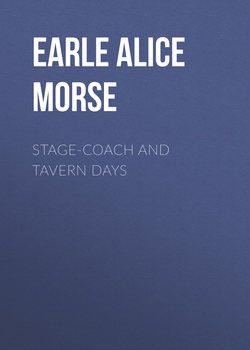Stage-coach and Tavern Days

Реклама. ООО «ЛитРес», ИНН: 7719571260.
Оглавление
Earle Alice Morse. Stage-coach and Tavern Days
CHAPTER I. THE PURITAN ORDINARY
CHAPTER II. OLD-TIME TAVERNS
CHAPTER III. THE TAVERN LANDLORD
CHAPTER IV. TAVERN FARE AND TAVERN WAYS
CHAPTER V “KILL-DEVIL” AND ITS AFFINES
CHAPTER VI. SMALL DRINK
CHAPTER VII. SIGNS AND SYMBOLS
CHAPTER VIII. THE TAVERN IN WAR
CHAPTER IX. THE TAVERN PANORAMA
CHAPTER X. FROM PATH TO TURNPIKE
CHAPTER XI. PACKHORSE AND CONESTOGA WAGON
CHAPTER XII. EARLY STAGE-COACHES AND OTHER VEHICLES
CHAPTER XIII. TWO STAGE VETERANS OF MASSACHUSETTS
CHAPTER XIV. A STAGING CENTRE
CHAPTER XV. THE STAGE-DRIVER
CHAPTER XVI. THE ROMANCE OF THE ROAD
CHAPTER XVII. THE PAINS OF STAGE-COACH TRAVEL
CHAPTER XVIII. KNIGHTS OF THE ROAD
CHAPTER XIX. TAVERN GHOSTS
Отрывок из книги
By the close of the seventeenth century the word ordinary was passing into disuse in America; public houses had multiplied vastly and had become taverns, though a few old-fashioned folk – in letters, and doubtless in conversation – still called them ordinaries – Judge Sewall was one. The word inn, universal in English speech, was little heard here, and tavern was universally adopted. Though to-day somewhat shadowed by a formless reputation of being frequently applied to hostelries of vulgar resort and coarse fare and ways, the word tavern is nevertheless a good one, resonant of sound and accurate of application, since to this present time in the commonwealth of Massachusetts and in other states such large and sumptuous caravansaries as the Touraine and the Somerset Hotel of Boston are in the eye and tongue of the law simply taverns, and their proprietors inn-holders or tavern-keepers.
In the Middle colonies ordinaries and inns were just as quickly opened, just as important, just as frequent, as in New England; but in the Southern colonies, the modes of settlement were so different, there were so few towns and villages, that hospitality to the traveller was shown at each plantation, every man’s home was an inn; every planter was a landlord.
.....
The taproom was usually the largest room of the tavern. It had universally a great fireplace, a bare, sanded floor, and ample seats and chairs. Usually there was a tall, rather rude writing-desk, at which a traveller might write a letter, or sign a contract, and where the landlord made out his bills and kept his books. The bar was the most interesting furnishing of this room. It was commonly made with a sort of portcullis grate, which could be closed if necessary. But few of these bars remain; nearly all have been removed, even if the tavern still stands. The taproom of the Wayside Inn at Sudbury, Massachusetts, is shown on page 19. It is a typical example of a room such as existed in hundreds of taverns a century ago. Another taproom may still be seen in the Wadsworth Inn. This well-built, fine old house, shown on page 47, is a good specimen of the better class of old taverns. It is three miles from Hartford, Connecticut, on the old Albany turnpike. It was one of twenty-one taverns within a distance of twenty miles on that pike. It was not a staging inn for every passing coach, but enjoyed an aristocratic patronage. The property has been in the same family for five generations, but the present building was erected by Elisha Wadsworth in 1828. It is not as old as the member of the Wadsworth family who now lives in it, Miss Lucy Wadsworth, born in 1801. Its old taproom is shown on page 51. This tavern was a public house till the year 1862.
Some of the furnishings of the taproom of the old Mowry Inn still are owned by Landlord Mowry’s descendants, and a group of them is shown on page 7. Two heavy glass beakers brought from Holland, decorated with vitrifiable colors like the Bristol glass, are unusual pieces. The wooden tankard, certainly two centuries old, has the curious ancient lid hinge. The Bellarmine jug was brought to America filled with fine old gin from Holland by Mayor Willet, the first Mayor of New York City. The bowl is one of the old Indian knot bowls. It has been broken and neatly repaired by sewing the cracks together with waxed thread. The sign-board of this old inn is shown on page 57. The house stood on the post-road between Woonsocket and Providence, in a little village known as Lime Rock. As it was a relay house for coaches, it had an importance beyond the size of the settlement around it.
.....